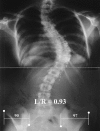Transverse plane pelvic rotation in adolescent idiopathic scoliosis: primary or compensatory?
- PMID: 17668251
- PMCID: PMC2078296
- DOI: 10.1007/s00586-007-0400-4
Transverse plane pelvic rotation in adolescent idiopathic scoliosis: primary or compensatory?
Abstract
Several studies have suggested that the pelvis is involved in the etiology or pathogenesis of adolescent idiopathic scoliosis (AIS). The purpose of this retrospective, cross-sectional radiographic study is to identify any correlation between the transverse plane rotational position of the pelvis in stance and operative-size idiopathic or congenital scoliosis deformities, using Scheuermann's kyphosis and isthmic spondylolisthesis patients for comparison. The hypothesis tested was that the direction of transverse pelvic rotation is the same as that for a thoracic scoliosis. As a group, AIS patients had a significant transverse plane pelvic rotation in the same direction as the thoracic curve. When subdivided into the six Lenke curve patterns, this was true for the groups with a major thoracic curve: thoracic (1), double thoracic (2) and double curve patterns (3). It was not true for patterns with a major thoracolumbar/lumbar curve: single thoracolumbar/lumbar (5) and double thoracic-thoracolumbar/lumbar (6). Nor was it true for triple (4) curves. The Lenke 1 and 2 major thoracic curves without compensatory thoracolumbar/lumbar curves did not have the predicted pelvic rotation. All congenital scoliosis patients studied had main thoracic curves and significant transverse plane pelvic rotation in the same direction as the thoracic curve. There was no transverse plane pelvic rotation in the Scheuermann's kyphosis or isthmic spondylolisthesis patients. We interpret these findings as consistent with a compensatory rotation of the pelvis in the same direction as the main thoracic curve in most patients with a compensatory thoracolumbar/lumbar curve as well as in patients with main thoracic congenital scoliosis.
Figures


Similar articles
-
Characteristics of the pelvic axial rotation in adolescent idiopathic scoliosis: a comparison between major thoracic curve and major thoracolumbar/lumbar curve.Spine J. 2014 Sep 1;14(9):1873-8. doi: 10.1016/j.spinee.2013.10.036. Epub 2013 Nov 12. Spine J. 2014. PMID: 24231783
-
The effectiveness of selective thoracic fusion for treating adolescent idiopathic scoliosis: a systematic review protocol.JBI Database System Rev Implement Rep. 2015 Nov;13(11):4-16. doi: 10.11124/jbisrir-2015-2338. JBI Database System Rev Implement Rep. 2015. PMID: 26657460
-
Axial plane analysis of Lenke 1A adolescent idiopathic scoliosis as an aid to identify curve characteristics.Spine J. 2014 Oct 1;14(10):2425-33. doi: 10.1016/j.spinee.2014.02.015. Epub 2014 Feb 14. Spine J. 2014. PMID: 24534387
-
Selective Thoracic Fusion of Lenke I and II Curves Affects Sagittal Profiles But Not Sagittal or Spinopelvic Alignment: A Case-Control Study.Spine (Phila Pa 1976). 2015 Jun 15;40(12):926-34. doi: 10.1097/BRS.0000000000000861. Spine (Phila Pa 1976). 2015. PMID: 26067149 Review.
-
Selective thoracic fusion for adolescent idiopathic scoliosis with C modifier lumbar curves: 2- to 16-year radiographic and clinical results.Spine (Phila Pa 1976). 2004 Mar 1;29(5):536-46. doi: 10.1097/01.brs.0000109992.22248.77. Spine (Phila Pa 1976). 2004. PMID: 15129068 Review.
Cited by
-
Postoperative improvement in leg length discrepancy in adolescent idiopathic scoliosis differs between right and left legs.N Am Spine Soc J. 2022 Mar 21;10:100114. doi: 10.1016/j.xnsj.2022.100114. eCollection 2022 Jun. N Am Spine Soc J. 2022. PMID: 35464492 Free PMC article.
-
Gait in adolescent idiopathic scoliosis: kinematics and electromyographic analysis.Eur Spine J. 2009 Apr;18(4):512-21. doi: 10.1007/s00586-009-0899-7. Epub 2009 Feb 18. Eur Spine J. 2009. PMID: 19224255 Free PMC article.
-
Factors affecting pelvic rotation in idiopathic scoliosis: Analysis of 85 cases in a single center.Medicine (Baltimore). 2016 Nov;95(46):e5458. doi: 10.1097/MD.0000000000005458. Medicine (Baltimore). 2016. PMID: 27861399 Free PMC article.
-
Don't forget the pelvis: accounting for pelvic rotation in the preoperative assessment of adolescent idiopathic scoliosis.J Spine Surg. 2021 Jun;7(2):181-189. doi: 10.21037/jss-20-675. J Spine Surg. 2021. PMID: 34296030 Free PMC article.
-
Relative shortening and functional tethering of spinal cord in adolescent scoliosis - Result of asynchronous neuro-osseous growth, summary of an electronic focus group debate of the IBSE.Scoliosis. 2008 Jun 27;3:8. doi: 10.1186/1748-7161-3-8. Scoliosis. 2008. PMID: 18588673 Free PMC article.
References
-
- Bunnell WP. An objective criterion for scoliosis screening. J Bone Joint Surg Am. 1984;66:1381–1387. - PubMed
-
- Burwell RG, Cole AA, Cook TA, Grivas TA, Kiel AW, Moulton A, Thirlwall AS, Upadhyay SS, Webb JK, Wemyss-Holden SA, Whitwell DJ, Wojcik AS, Wythers DJ. Pathogenesis of idiopathic scoliosis. The Nottingham concept. Acta Orthop Belg. 1992;58(Suppl 1):33–58. - PubMed
MeSH terms
LinkOut - more resources
Full Text Sources
Medical
Research Materials

